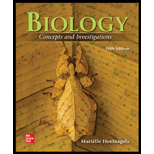
Concept explainers
You discover that a 24,000-year-old fossil has one fourth the concentration of a radioactive isotope compared to a living organism.
What is the half-life of this isotope?
- a. 3000 years
- b. 6000 years
- c. 8000 years
- d. 12,000 years
Introduction:
The radioactive isotopes are used for the determining the age of fossils. The half-life of the radioactive isotope is used and the age of the fossil is calculated. The technique of using radioactive isotopes in determining the age of fossils is called radioactive dating.
Answer to Problem 1MCQ
Correct answer:
The half-life of the isotope is
Explanation of Solution
Reason for the correct statement:
The formula for the calculation of the half-life of an isotope where A is the remaining amount of the radioactive isotope,
Here, the concentration of the radioactive isotope is one-fourth that of the original matter. So, the A is equal to one fourth of
Option d. is given as “
As, “the half-life for the radioactive isotope is
Hence, the option d. is correct.
Reasons for the incorrect statements:
Option a. is given as “
The half-life of the radioactive isotope will be
Option b. is given as “
The half-life of the radioactive isotope will be
Option c. is given as “
The half-life of the radioactive isotope will be
Hence, options a., b., and c. are incorrect.
The half-life for the radioactive isotope is
Want to see more full solutions like this?
Chapter 13 Solutions
Biology: Concepts and Investigations
Additional Science Textbook Solutions
Genetics: From Genes to Genomes
Chemistry: An Introduction to General, Organic, and Biological Chemistry (13th Edition)
Campbell Essential Biology (7th Edition)
HUMAN ANATOMY
Physical Science
Biology: Life on Earth with Physiology (11th Edition)
- Noggin mutation: The mouse, one of the phenotypic consequences of Noggin mutationis mispatterning of the spinal cord, in the posterior region of the mouse embryo, suchthat in the hindlimb region the more ventral fates are lost, and the dorsal Pax3 domain isexpanded. (this experiment is not in the lectures).a. Hypothesis for why: What would be your hypothesis for why the ventral fatesare lost and dorsal fates expanded? Include in your answer the words notochord,BMP, SHH and either (or both of) surface ectoderm or lateral plate mesodermarrow_forwardNot part of a graded assignment, from a past midtermarrow_forwardNot part of a graded assignment, from a past midtermarrow_forward
- please helparrow_forwardWhat does the heavy dark line along collecting duct tell us about water reabsorption in this individual at this time? What does the heavy dark line along collecting duct tell us about ADH secretion in this individual at this time?arrow_forwardBiology grade 10 study guidearrow_forward

 Concepts of BiologyBiologyISBN:9781938168116Author:Samantha Fowler, Rebecca Roush, James WisePublisher:OpenStax College
Concepts of BiologyBiologyISBN:9781938168116Author:Samantha Fowler, Rebecca Roush, James WisePublisher:OpenStax College Biology Today and Tomorrow without Physiology (Mi...BiologyISBN:9781305117396Author:Cecie Starr, Christine Evers, Lisa StarrPublisher:Cengage Learning
Biology Today and Tomorrow without Physiology (Mi...BiologyISBN:9781305117396Author:Cecie Starr, Christine Evers, Lisa StarrPublisher:Cengage Learning Biology (MindTap Course List)BiologyISBN:9781337392938Author:Eldra Solomon, Charles Martin, Diana W. Martin, Linda R. BergPublisher:Cengage LearningEssentials Health Info Management Principles/Prac...Health & NutritionISBN:9780357191651Author:BowiePublisher:Cengage
Biology (MindTap Course List)BiologyISBN:9781337392938Author:Eldra Solomon, Charles Martin, Diana W. Martin, Linda R. BergPublisher:Cengage LearningEssentials Health Info Management Principles/Prac...Health & NutritionISBN:9780357191651Author:BowiePublisher:Cengage Human Biology (MindTap Course List)BiologyISBN:9781305112100Author:Cecie Starr, Beverly McMillanPublisher:Cengage Learning
Human Biology (MindTap Course List)BiologyISBN:9781305112100Author:Cecie Starr, Beverly McMillanPublisher:Cengage Learning





